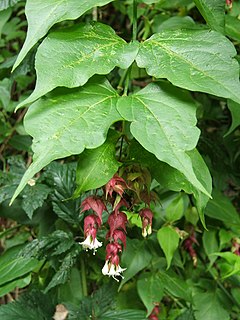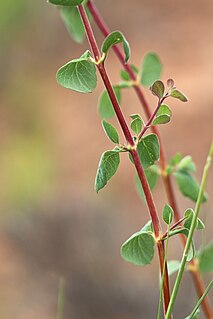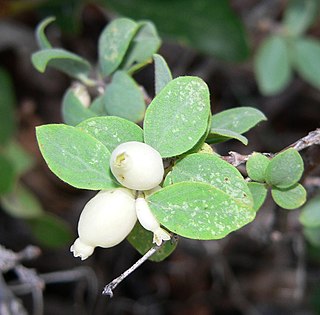
Symphoricarpos, commonly known as the snowberry, waxberry, or ghostberry, is a small genus of about 15 species of deciduous shrubs in the honeysuckle family, Caprifoliaceae. With the exception of the Chinese coralberry, S. sinensis, which is indigenous to western China, all species are native to North and Central America. The name of the genus is derived from the Ancient Greek words συμφορεῖν (sumphoreîn), meaning "to bear together", and καρπός (karpós), meaning "fruit". It refers to the closely packed clusters of berries the species produce.

Leycesteria formosa, the Himalayan honeysuckle, flowering nutmeg, Himalaya nutmeg or pheasant berry, is a deciduous shrub in the family Caprifoliaceae, native to the Himalaya and southwestern China. It is considered a noxious invasive species in Australia, New Zealand, the neighboring islands of Micronesia, and some other places.
The Guatemalan vole is a species of rodent in the family Cricetidae. It is found in Guatemala and Chiapas, Mexico, in montane pine-oak forest and meadow at elevations between 2600 and 3100 m above sea level. It is terrestrial and probably diurnal or crepuscular.
The Guatemalan deer mouse is a species of rodent in the family Cricetidae. It is found in Guatemala and Mexico.

Plectrohyla guatemalensis, also known as the Guatemala spikethumb frog, is a species of frog in the family Hylidae. It occurs in the highlands of the Sierra Madre from southeastern Chiapas, Mexico, and eastward through the central and southwestern highlands of Guatemala to northwestern El Salvador as well as the Sierra de Nombre de Dios in north-central Honduras. It might be a composite of more than one species.

Symphoricarpos mollis, with the common names creeping snowberry, Southern California snowberry, and trip vine, is a shrub in the Honeysuckle Family (Caprifoliaceae). It is found in western North America from British Columbia to California inland to Nevada and Idaho.

Rojasianthe is a genus of Mesoamerican flowering plants in the sunflower family.

Passiflora guatemalensis, the Guatemala passion vine, is a species in the Passifloraceae family. It is native to Guatemala, and found from southern Mexico through Central America to Venezuela.

Symphoricarpos longiflorus is a species of flowering plant in the honeysuckle family known by the common names desert snowberry and fragrant snowberry. It is native to the western United States from the Great Basin to western Texas, as well as northwestern Mexico.

Symphoricarpos rotundifolius is a North American subshrub in the honeysuckle family, also known by the common name round-leaved snowberry.

Symphoricarpos oreophilus is a North American species of flowering plant in the Caprifoliaceae, or honeysuckle family, known by the common name mountain snowberry. It has a wide distribution in western Canada, the United States, and northwestern Mexico. It is found in mountainous areas such as the Cascades, the Sierra Nevada, the Rockies, and the Sierra Madre Occidental from British Columbia to the Copper Canyon region of Chihuahua, from the coastal states as far inland as the Black Hills, the Oklahoma Panhandle, and trans-Pecos Texas.
Morchella guatemalensis is a species of ascomycete fungus in the family Morchellaceae. Described as new to science in 1985, it is found in Chimaltenango Department (Guatemala), where it grows in oak and cypress woodland. The fruit body has a white stipe and orangish cap.

Bidens aurea is a North American species of flowering plant in the daisy family. It is widespread across much of Mexico and found also in Arizona and Guatemala. The species is also naturalized in parts of Europe and South America.
Brickellia kellermanii is a Mesoamerican species of flowering plants in the daisy family. It is native to Central America and southern Mexico (Chiapas).

Cirsium horridulum, called bristly thistle, horrid thistle, yellow thistle or bull thistle, is a North American species of plants in the thistle tribe within the sunflower family. It is an annual or biennial. The species is native to the eastern and southern United States from New England to Florida, Texas, and Oklahoma as well as to Mexico, Belize, Guatemala, Honduras, and the Bahamas.
Erigeron jamaicensis is a Caribbean and Mesoamerican species of flowering plant in the daisy family commonly called Jamaican fleabane. It is native to Mexico, Central America, and the Greater Antilles.
Erigeron aquarius is a Central American species of flowering plant in the daisy family. It has been found only in Guatemala and Honduras. The Type specimen was collected in Guatemala in 1939.
Symphoricarpos microphyllus, the pink snowberry, is a North American species of flowering plant in the honeysuckle family. It is widespread across much of Mexico from Chihuahua to Chiapas, and found also in Guatemala, Honduras, and the US State of New Mexico.
Symphoricarpos parishii, or Parish's snowberry, is a North American species of flowering plant in the honeysuckle family. It had been found in California, Nevada, Arizona, and Baja California.












